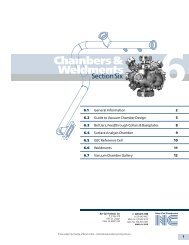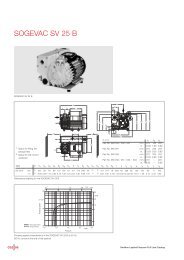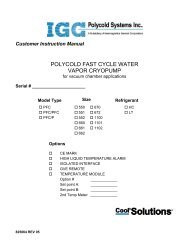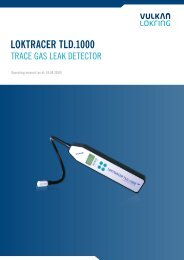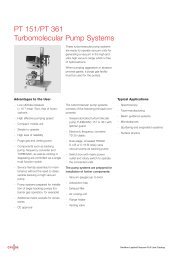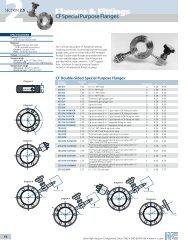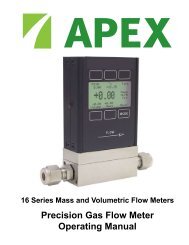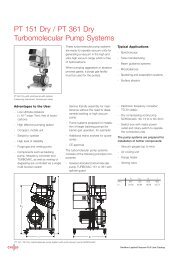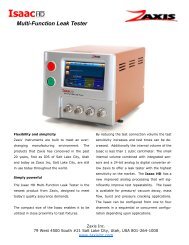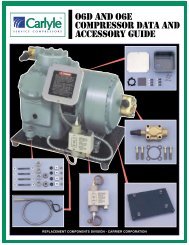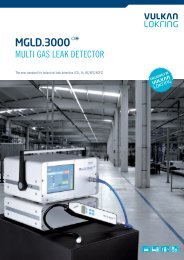INFICON CATALOG 2000-2001 - Schoonover, Inc.
INFICON CATALOG 2000-2001 - Schoonover, Inc.
INFICON CATALOG 2000-2001 - Schoonover, Inc.
You also want an ePaper? Increase the reach of your titles
YUMPU automatically turns print PDFs into web optimized ePapers that Google loves.
Pirani Standard Gauge<br />
Vacuum Gauges<br />
Pirani Standard Gauge<br />
PSG400, PSG400-S<br />
The Pirani Standard Gauge PSG400 represents the most advanced<br />
Pirani technology in a very compact, rugged package. The improved<br />
temperature compensation by the incorporated twin Pirani provides<br />
faster, more stable vacuum measurement and eliminates the slow<br />
response towards atmospheric pressures. The rugged stainless steel<br />
sensor cell qualifies it for use on semiconductor systems, as well as<br />
traditional applications such as fore vacuum lines.<br />
Patent granted on electronics<br />
Advantages<br />
♦ Small footprint<br />
♦ Mount in any orientation<br />
♦ Metal sealed feedthrough with stainless steel measuring cell<br />
♦ Optimized temperature compensation with twin Pirani principle<br />
♦ Logarithmic signal output for easy integration<br />
♦ High overpressure capability to 10 bar absolute with<br />
threaded connections<br />
♦ Bakeable version available for 250 ¡C at flange<br />
♦ Sensor cell easily replaced<br />
Typical Applications<br />
♦ Controlling of high vacuum ionization gauges<br />
♦ Fore vacuum pressure monitoring<br />
♦ Safety circuits in vacuum systems<br />
♦ General vacuum measurement and control in fine and rough<br />
vacuum range<br />
Advantages of PSG400 Over<br />
Conventional Technology<br />
In conventional Pirani gauges the filament used as measurement element is<br />
one arm of a self-adjusting bridge circuit. The filament temperature is in the<br />
range of 120 ¡C. Whenever a pressure change occurs a gain control<br />
amplifier automatically adjusts the bridge voltage to keep the filament<br />
temperature constant. This bridge excitation is the primary measurement<br />
used in determining the pressure. The ambient operating temperature also<br />
has an influence on the power necessary to keep the filament temperature<br />
constant. Ambient temperature changes appear as changes in pressure.<br />
To compensate, a temperature sensitive element is placed close to the<br />
sensor. The ambient temperature is thus registered and the measurement<br />
signal is compensated, accordingly.<br />
Advanced PSG400<br />
This sensor consists of two filaments, which are kept constant at two<br />
separate operating temperatures (65 ¡C and 120 ¡C). A change in pressure<br />
affects both filaments the same way. The power required to keep the<br />
filaments at the constant temperature is pressure dependent. By using the<br />
power difference between the two filaments one can easily eliminate<br />
changes in the temperature and thus isolate the changes in pressure.<br />
This satisfies the need for temperature compensation, but eliminates the<br />
delays associated with using a separate temperature sensor, resulting in<br />
a very fast response time.<br />
B6<br />
B6.15



